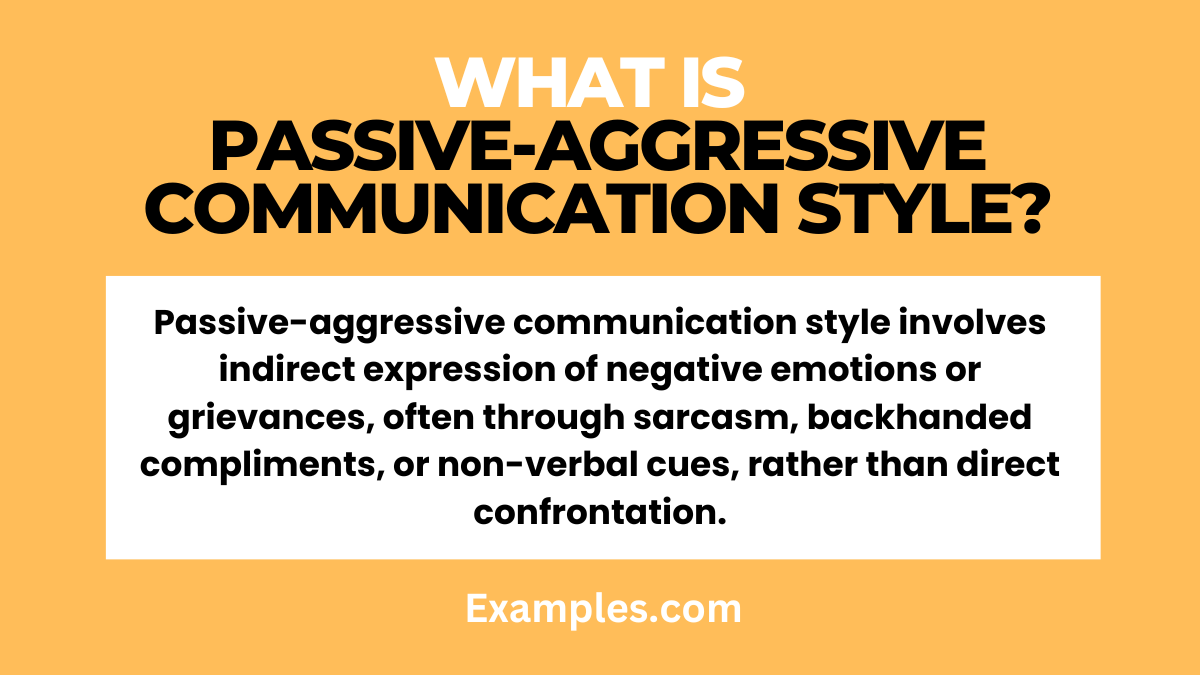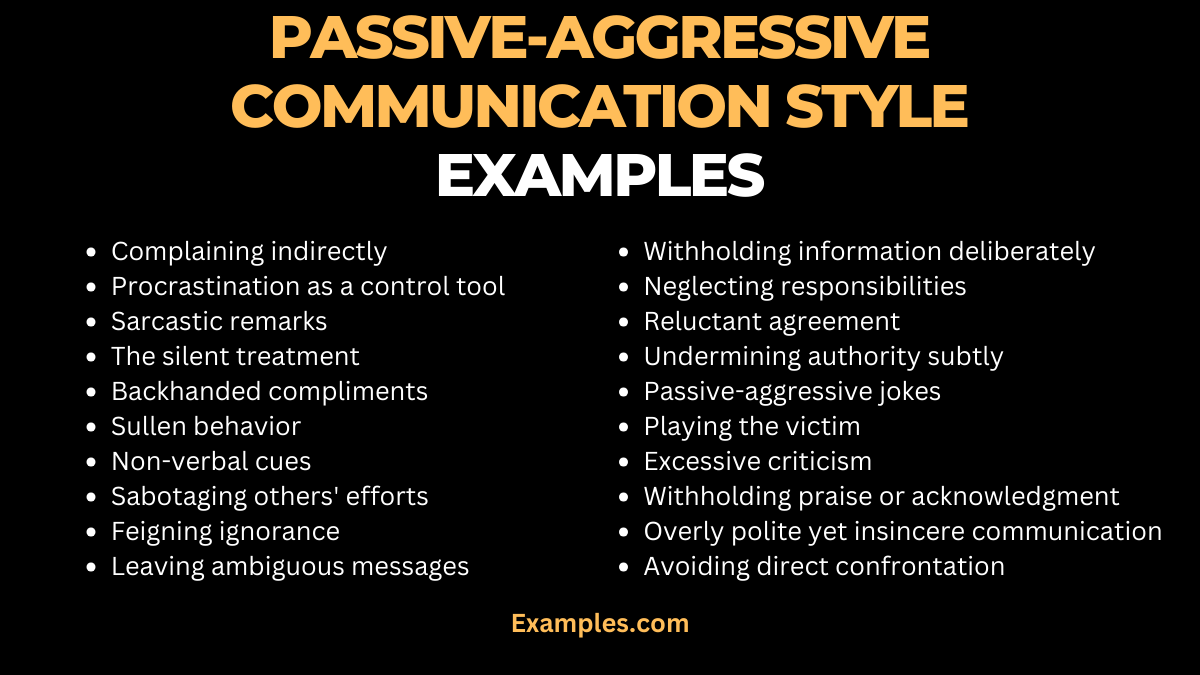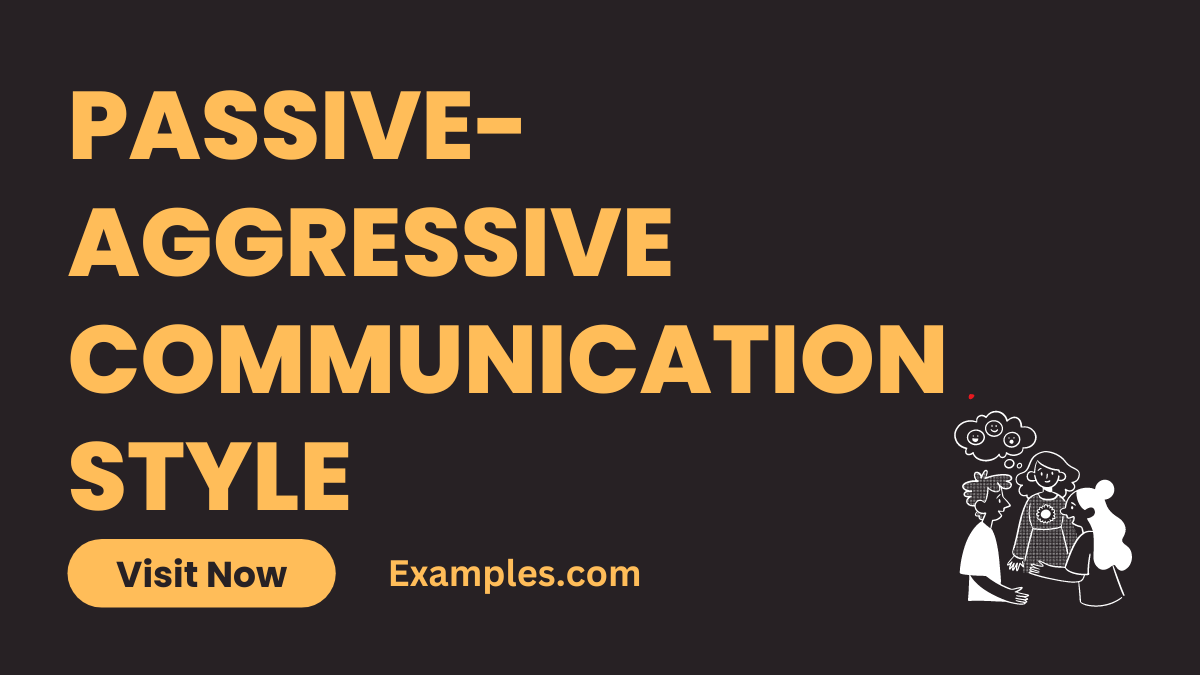Passive-Aggressive Communication Style
The Passive-Aggressive Communication Style is a complex and nuanced mode of interaction often characterized by indirect resistance and avoidance of direct confrontation. In this complete guide, we delve into the subtleties of this communication style, offering vivid communication examples to illustrate its practical implications in various settings. Understanding this style is crucial for navigating complex interpersonal dynamics effectively.
Download Passive-Aggressive Communication Style in PDFWhat is Passive-Aggressive Communication Style? – Definition

Passive-aggressive communication style is a way of expressing negative feelings indirectly rather than openly addressing them. It involves subtle actions or words that convey disapproval or discontent, but without direct confrontation. This style can manifest in passive-aggressive behavior, silent treatment, or sarcasm. It often leads to misunderstandings and conflict in relationships, as the true intentions or emotions of the communicator are not clearly expressed. Understanding this style is essential for addressing passive-aggressive personality traits and improving communication dynamics.
20 Passive-Aggressive Communication Style Examples

Passive-aggressive communication often manifests in subtle, indirect expressions of displeasure or disagreement. These behaviors can be hard to identify but have a significant impact on relationships and workplace dynamics. Here are 20 unique examples that illustrate how passive-aggressive communication can surface, along with a brief explanation and Example sentences for each scenario.
- Complaining indirectly: Expressing discontent to others rather than to the person involved.
Example: “I guess some people just don’t care about deadlines.” - Procrastination as a control tool: Intentionally delaying tasks as a form of resistance.
Example: “I’ll get to it eventually, no need to rush.” - Sarcastic remarks: Using sarcasm to mask true feelings.
Example: “Great job on that report, just like always.” - The silent treatment: Withholding communication to express disapproval.
Example: Ignoring someone’s attempts to converse. - Backhanded compliments: Giving compliments that actually feel like insults.
Example: “You finally did something right for a change.” - Sullen behavior: Displaying moodiness or sulking to convey discontent.
Example: Sighing heavily when asked to participate. - Non-verbal cues: Using body language to show displeasure, like eye-rolling.
Example: Rolling eyes in response to a request. - Sabotaging others’ efforts: Deliberately hindering progress subtly.
Example: “I forgot to mention that deadline, sorry.” - Feigning ignorance: Pretending not to understand to avoid responsibility.
Example: “I had no idea you needed that done today.” - Leaving ambiguous messages: Communicating in a way that’s open to interpretation.
Example: “Do whatever you think is best, I guess.” - Withholding information deliberately: Not sharing needed information as a form of control.
Example: “I thought you knew how to do it.” - Neglecting responsibilities: Ignoring duties to express resentment.
Example: “I didn’t think it was that important to finish today.” - Reluctant agreement: Agreeing to tasks but with obvious reluctance.
Example: “Fine, I’ll do it, but don’t expect much.” - Undermining authority subtly: Showing disrespect to authority in indirect ways.
Example: “Sure, I’ll follow your ‘expert’ advice.” - Passive-aggressive jokes: Making jokes that are actually veiled criticisms.
Example: “Just joking, but seriously, you should know better.” - Playing the victim: Portraying oneself as the unfairly treated party.
Example: “I’m always the one who has to sacrifice.” - Excessive criticism: Criticizing excessively but cloaking it as ‘helpful feedback’.
Example: “I’m only telling you this for your own good.” - Withholding praise or acknowledgment: Not recognizing others’ efforts intentionally.
Example: Ignoring someone’s achievement in a group setting. - Overly polite yet insincere communication: Being excessively polite to mask true feelings.
Example: “Thank you soooo much for your ‘valuable’ input.” - Avoiding direct confrontation: Steering clear of addressing issues head-on.
Example: “It’s fine, I don’t want to make a big deal out of it.”
Recognizing these examples is the first step in addressing and improving communication styles that may be impacting personal and professional relationships.
Tips for Improving Passive-Aggressive Communication Style
Improving a passive-aggressive communication style involves developing self-awareness and understanding its impact on interpersonal dynamics. Start by acknowledging passive-aggressive behaviors, such as passive-aggressive personality traits, and actively work towards more direct and transparent communication methods. Encourage open dialogue and actively practice expressing feelings and thoughts honestly and respectfully. Engaging in active listening is crucial to understand others’ perspectives and foster empathy. Seeking constructive feedback from peers can be beneficial, as can professional guidance or workshops focusing on communication skills development. Embracing assertiveness, while avoiding overt aggression or passivity, can lead to more effective and harmonious interactions.
Benefits of Passive-Aggressive Communication Style
Despite its challenges, understanding the potential benefits of a passive-aggressive communication style can offer valuable insights. This style can act as a defense mechanism in environments where direct expression is frowned upon. It allows for expressing disagreement or displeasure subtly, which can be tactically advantageous in certain hierarchical or rigid organizational structures. Recognizing and empathizing with the use of passive-aggressive tactics can lead to more constructive conversations about communication preferences and strategies. Understanding this style can also reveal underlying issues in relationships or organizational cultures, prompting discussions that lead to healthier communication dynamics and organizational changes.
5 Ways to Improve Your Passive-Aggressive Communication Style
Transforming a passive-aggressive communication style into a more effective and constructive approach can greatly enhance interpersonal relationships and workplace dynamics. Here are five key ways to achieve this transformation:
- Develop Self-Awareness: Acknowledge and understand your passive-aggressive behaviors. Reflect on your communication patterns and identify situations where you could have been more direct.
- Embrace Open Communication: Practice expressing your thoughts and feelings openly and clearly, avoiding indirect or ambiguous language.
- Improve Active Listening: Focus on actively listening to others, which helps in understanding their perspectives and responding empathetically.
- Manage Emotions Constructively: Learn to recognize and control your emotions, reducing the likelihood of resorting to passive-aggressive responses.
- Seek Feedback and Support: Encourage feedback from others about your communication style and consider seeking support from a professional if needed.
By implementing these strategies, you can move towards a more assertive and transparent way of communicating, fostering healthier and more productive interactions.
What Does Passive-Aggressive Communication Look Like?
Passive-aggressive communication often involves indirect expressions of anger or displeasure, like sarcasm, silent treatment, and subtle insults, masking true feelings under a guise of passive behavior.
What Emotions Drive Passive-Aggressive Communication?
Passive-aggressive communication is typically driven by emotions like resentment, frustration, or helplessness, often stemming from an inability to express anger or disagreement openly.
What Are the Goals of Passive-Aggressive Communication?
The goals of passive-aggressive communication include indirectly expressing negative feelings, avoiding direct conflict, and exerting control or punishment without overt aggression.
Additionally, enhancing one’s communication skills, particularly in challenging dynamics like passive-aggressiveness, is key to personal and professional development. The Center for Creative Leadership provides comprehensive resources and training for improving communication in various styles, which can be found at Center for Creative Leadership: Communication.
Understanding and addressing passive-aggressive communication is crucial for healthier interpersonal interactions. Recognizing the signs, understanding the underlying emotions, and adopting strategies for improvement can transform this communication style into more constructive and transparent exchanges, enhancing both personal and professional relationships. This shift fosters a more open, honest, and effective communication environment.



